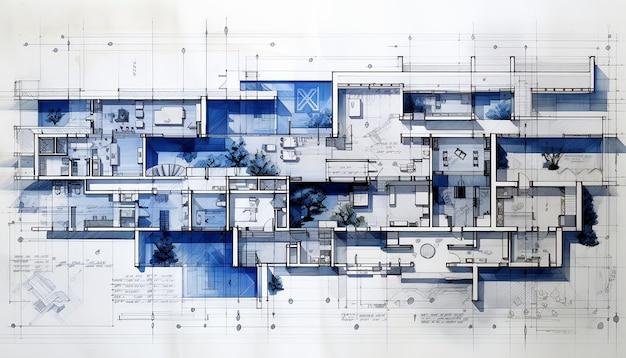When it comes to understanding architectural drawings, knowing the difference between plan view and elevation view is crucial. Whether you’re a design enthusiast, an aspiring architect, or someone simply curious about the world of architecture, this blog post is here to provide you with all the answers. So, what exactly are plan view and elevation view?
In simple terms, plan view refers to a top-down view of an object, giving us a bird’s eye perspective. On the other hand, elevation view presents a side view of an object, showing its height, depth, and proportions. These two types of architectural drawings serve different purposes in the design process, helping architects and engineers accurately depict and visualize their ideas.
In this comprehensive guide, we will delve into the distinctions between plan view and elevation view, explore their applications, and uncover why they are essential in the realm of architecture. So, if you are ready to broaden your knowledge about architectural drawings, let’s dive right in!

What’s the Deal with Plan View and Elevation View?
Let’s dive into the fascinating world of architectural drawings and explore the intriguing differences between plan view and elevation view. 🏗️
Plan View: A Blueprint for Birds
When architects want to give you a bird’s-eye view of a building, they whip out the plan view. This nifty drawing shows us the building as if we were soaring above it like a majestic eagle – cue dramatic eagle sound effect 🦅
The plan view is like an aerial photograph, capturing the locations of walls, doors, and other architectural elements. It’s the perfect way to get a grasp on the layout and flow of a space, ensuring that you don’t accidentally bump into a wall on your way to the fridge at 2 a.m. (been there, done that).
Elevation View: The (Vertical) Heights of Drama
If plan view is like a bird’s-eye view, then elevation view is like a close-up shot from a dramatic movie scene. 🎥 It puts the spotlight on the building’s height, showing us its majestic facades and exterior details.
Rather than looking down from above, the elevation view lets us see the building as if we were standing right in front of it, craning our necks to take in all the architectural glory. It reveals the proportions, window placements, and other impressive features that make a building stand tall like a confident peacock. 🦚
Spotting the Differences:
1. Perspective Matters:
While the plan view gives us a god-like perspective from above, the elevation view puts us front and center, staring up at the building, somewhat awkwardly, as if we were on a first date with architecture. 🏰
2. It’s All About Direction:
The plan view is all about horizontal measurements, showing us the intricate layout of a space. Think of it as Robin Hood’s map, guiding us through Sherwood Forest. 🌳
On the other hand, the elevation view switches gears and highlights vertical dimensions. It’s more like a backstage pass to the construction site, letting us see how everything stacks up (literally) and catching those breathtaking architectural details.
So there you have it, my architectural aficionados! Plan view and elevation view are like two sides of the same building coin. The plan view gives us the big picture of a space, while the elevation view zooms in, showcasing the dramatic vertical heights and fine details.
Next time you find yourself admiring a building, take a moment to appreciate the artistry behind these architectural drawings. Plan view and elevation view work together to bring buildings to life, just like peanut butter and jelly or a catchy tune and a funky dance. 🎶
Stay tuned for more architectural adventures, and remember to always look up (and around) for inspiration. 💡

FAQ: Understanding the Difference between Plan View and Elevation View
What is the Full Form of GAD
GAD stands for “General Arrangement Drawing.” It is a comprehensive visual representation that showcases the arrangement and relationship between various elements, components, and systems within a project or design.
What is the Difference between Plan View and Elevation View
In architectural and construction terms, a plan view provides a top-down perspective of a project or design, showing the layout and arrangement of spaces and structures on a horizontal plane. On the other hand, an elevation view portrays the vertical appearance of an object or structure, allowing one to see its proportions, dimensions, and vertical elements from a face-on perspective.
What are Elevation Drawings
Elevation drawings, as the name suggests, are artistic renderings or technical illustrations that highlight the vertical aspects of an object or structure. These drawings are essential for architects, engineers, and designers as they provide a clear depiction of the facade, sides, and various vertical planes of a building or object.
What is the Use of Layout Drawing
Layout drawings play a crucial role in the planning and development of projects. They are like the guiding blueprint of a design, showcasing the arrangement and positioning of different elements, such as walls, rooms, furnishings, and other components. Layout drawings help in visualizing the overall structure and aid in decision-making during the design and construction process.
How do You Plan Elevation
Planning elevation requires careful consideration of design principles and the intended purpose of the structure. Here are a few steps to help you plan the elevation of a building:
-
Understand the Purpose: Determine the function and aesthetic requirements of the building. Whether it’s residential, commercial, or industrial, the purpose will influence the design choices for the elevation.
-
Research and Gather Inspiration: Look for inspiration from various sources, such as architectural magazines, online platforms, or even by exploring different neighborhoods. Understand the prevalent styles and design elements that resonate with your project.
-
Consider the Surroundings: Take into account the surrounding landscape, neighboring structures, and climate conditions. The elevation should harmonize with the environment and complement the existing architectural context.
-
Create Preliminary Sketches: Start by sketching rough outlines and refining the design. Experiment with different architectural styles, materials, textures, and shapes to bring your vision to life.
-
Collaborate with Professionals: Work with architects, designers, and engineers to refine your elevation plans. They can provide valuable insights and ensure that your design is structurally sound and functional.
What is Layout in Piping
In the context of piping systems, a layout refers to the arrangement and positioning of pipes, fittings, and equipment within a project. It involves mapping out the routing of pipelines, considering factors such as functionality, efficiency, safety, and adherence to design specifications. A well-planned layout ensures proper flow and distribution of fluids or gases while considering space constraints and accessibility for maintenance.
Remember, understanding the difference between plan view and elevation view is crucial for successful design and construction projects. Whether you’re an architect, student, or simply curious about the world of architecture, this knowledge will enhance your appreciation of the built environment around you. So, dive in, embrace your creative side, and let your imagination soar as you explore the realms of plan view and elevation view!
